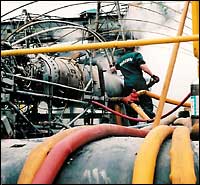DOE - Fossil Energy Techline - Issued on: June 2, 2003
Jet Engine Successful in Fighting Fire In West Virginia Coal Mine
Energy Department's Assistance Brings Coal Miners Back To Work One Year Early
Fairview, WV - A modified jet engine has been used to successfully fight a West Virginia mine fire that had been burning for nearly two months and was the cause of 300 employees being temporarily laid off when mine operations were idled. Positioned at the mouth of the one of the mineshafts, the jet engine was used to blow water vapor and inert gases into the mine to smother the fire by creating an inert environment underground. It was the first time the technique had been tried in the United States.
 | |
| By blowing its exhaust into the underground mine, the modified jet engine was able to snuff out the mine fire much faster than traditional methods. |
"As the Department of Energy continues its broad support of clean coal technologies, I never envisioned that we'd be using a jet engine to put out a mine fire," Secretary of Energy Spencer Abraham said. "But this achievement shows that we can make use of non-traditional techniques, as well as our more formal research programs, to provide a cleaner environment through the clean coal program."
The Department of Energy and the National Institutes of Occupational Safety and Health provided a portion of the costs to test the innovative fire suppression system at CONSOL Energy's Loveridge Mine near Fairview, in Marion County, W.Va.
By displacing oxygen in the mine with inert exhaust gases, the technique shaved months off the conventional method of sealing a mine and letting a fire burn itself out. At the Loveridge Mine it took 10 days of continuously blowing the jet exhaust into the mine to create an inert atmosphere underground. By extinguishing the fire through use of the jet engine, miners were able to reenter the mine more than 12 months sooner than if other fire-suppression techniques had been used.
The jet engine system was brought to West Virginia from Australia by a team from the Queensland Mine Rescue Service Ltd. Earlier versions of the technique have been used in other parts of the world, and a similar concept was employed in Kuwait to extinguish oil well fires following the Gulf War a decade ago.
The fire had begun on February 13 when a trash-filled mine car ignited near the bottom of a sloped entry shaft about 940 feet below the surface. Approximately 100 employees were safely evacuated from the mine.
"As we developed our firefighting and re-entry plan with state and federal agencies, we looked beyond the traditional approach of simply waiting for the fire area to cool. We determined that the safest and most expeditious alternative was to utilize the jet engine technology," said J. Brett Harvey, president and CEO of CONSOL Energy. "We appreciate the support of DOE in helping to bring this technology to our mine."
The jet engine and associated equipment - which together weighed more than five tons - arrived at the mine site on Friday, April 4. After engineers assembled it, the engine was turned on later that day. Employing a recirculating water-cooled afterburner, the jet engine was run at about half speed so as not to develop thrust. It blew roughly 64,000 cubic feet of water vapor, nitrogen and carbon dioxide into the mine.
On April 14, mine rescue teams wearing self-contained breathing packs entered the mine to begin exploration and rehabilitation of the fire area.
Safety experts from the federal Mine Safety and Health Administration, West Virginia's Office of Miners' Health, Safety and Training, and the United Mine Workers of America joined with CONSOL Energy to monitor the effort. The joint team approved the firefighting plan as well as plans to reenter and restart mine operations.
- End of Techline -
For more information, contact:
David Anna, DOE National Energy Technology Laboratory, 412-386-4646, anna@netl.doe.gov
Media Contacts:
Drew Malcomb, 202/586-5806